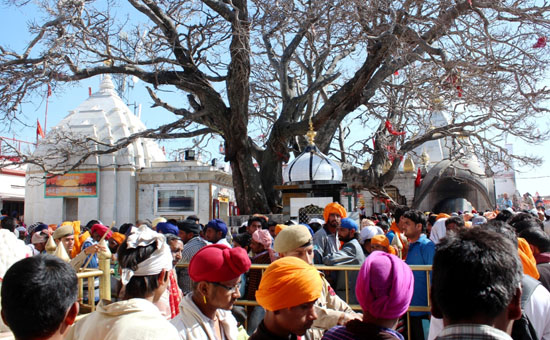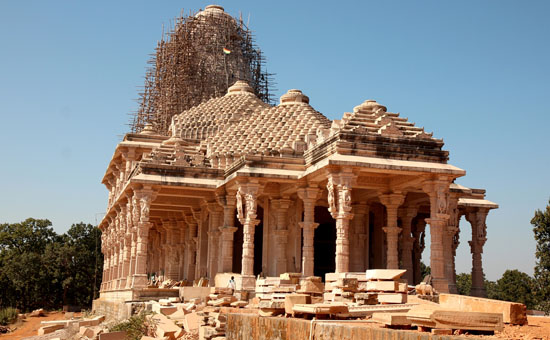-
During a recent visit to Omkareshwar was sad to see the ruins of the Siddhanath Temple. Images of carved elephants were broken. Locals told me the temple was damaged by foreign invaders. Conversely a few months earlier visited Ellora where Hindu, Buddhist and Jain caves that co-existed. Based on author’s travels this article gives examples of co-existence Hindu, Buddhist and Jain and Sikh monuments.
During a recent visit to Omkareshwar in Madhya Pradesh was sad to see the ruins of the Siddhanath Temple on Mandhata hill. Images of carved elephants were broken – some did not have a trunk others not a head. Locals told me the temple was damaged by foreign invaders. Conversely a few months earlier visited Ellora where Hindu, Buddhist and Jain caves co-existed for centuries.
Surely
there are variations in Indian thought. However, they are not monolithic and
homogenizing like Abrahamic religions. We must realize that the Dharmic
way gives its followers the freedom to choose multiple paths.
Based on author’s travels this article gives examples of co-existence Hindu, Buddhist and Jain and Sikh (referred to H, B, J and S hereafter) monuments. Next it gives details of common pilgrimage places.
First is details of monuments.
Ellora Caves Maharashtra (7-11 century)
Close
to Aurangabad are Ellora caves of which the Kailasa Temple is the most famous.
The Buddhist caves are datable to the 7th and 8th
century, Jain to the 10 to 11th century and Hindu from the 7th
to 11th centuries A.D. In fact Jain Cave 30 is an unfinished excavation of what is popularly known as ‘Chhota Kailasa’ because it is a replica of the Kailasa temple.
What struck me is the co-existence of 34 caves of which 17 are Hindu, 12
Buddhist and 5 Jain.
Badami Caves Karnataka (6th century)
There are four rock-cut temples (caves) of which first is Shiva, second
is Vishnu, third is Maha Vishnu and fourth is Jaina. A natural Buddhist cave
exists too. Although its makers, the Chalukyas, were Vaishnavites they allowed
other temples to be built.
Minutes away and at the base of the Badami Fort are ‘The Bhutanatha Group of Temples’. A cave in his group has a sculpture of Buddha.
Aihole Temples Karnataka (6-12th centuries)
In Aihole there are numerous temples and caves, Hindu, Buddhist and Jain. In local parlance the Jain group is called ‘Jaina Narayana’ or ‘Yogi Narayana’.
Note the caves are dedicated to Shiva, Vishnu, Buddha and Jain
Tirthankaras. The word Hindu was not used to describe caves dedicated to Shiva
and Vishnu.
Mount Kailash
The holy mountain is worshipped by Hindus, Buddhists and Jains for different reasons. For Hindus it the abode of Lord Shiva. For Jains it is where the first Jain Tirthankara Rishabhdeva attained liberation from rebirth. Tibetan Buddhists “believe that Kailash is the home of the Buddha Demchok (also known as Demchog or Chakrasamvara), who represents supreme bliss.”
In Ellora caves there are numerous sculptures of Shiva and
Parvati sitting on Mount Kailash. The most outstanding rock-cut temple is
KAILASHA.
When this author visited Tibet in 1998, Saivites, Jains,
Nepali & Tibetan Buddhists simultaneously offered Pranams to Mount Kailash
when we first saw it. It was this holy mountain that united us at a deeper and
spiritual level.
Khajuraho Madhya Pradesh (950 to 1050 A.D.)
Khajuraho has temples of Shaiva, Vaishnava and Jaina sects.
There are temples dedicated to Shiva, Ramachandra and Parshvanatha amongst
others.
The above are only a few examples of peaceful co-existence. Yet
some are unable to accept that Hindus, Buddhists and Jains lived in harmony!
To H, B, J add Sikh and refer to them as followers of Dharma.
During pilgrimages found many places that attract H, B, J & S devotees even
though the reasons for visiting are different.
Some common pilgrimage places.
Rewalsar Lake Himachal Pradesh
About 25 kms from Mandi is Rewalsar Lake i.e. important to
Hindus, Buddhists and Sikhs alike. According to tradition the great Tantric Padmasambhava used his enormous powers to take flight to Tibet from Rewalsar. It was under Padmasambhava’s influence that Mahayana Buddhism took root in Tibet and at Rewalsar waters his spirit is said to reside in the tiny island of floating reed that drift over the waters. A statue of Padmasambhava overlooks the lake.
The 10th Guru, Govind Singhji spent a month here.
The Gurudwara was built in 1930 under the patronage of Raja Joginder Sen of
Mandi.
The town also has three temples dedicated to Shiva, Sri
Krishna and sage Lomas.
Naina Devi Temple Himachal Pradesh
The temples attracts Hindu and Sikh devotees. The temple is
one of the 51 Shakti Peeths where limbs of Sati fell on earth.
In
the Chandi Charitra, Guru Govind Singhji says that in the past god had deputed Goddess Durga to destroy evil doers. That duty was now assigned to him hence he wanted her blessings. So he invited Pandit Kesho from Kashi to conduct the ceremony at the hill of Naina Devi. The ceremony started on Durga Ashtami day, in the autumn of October 1698, and lasted for six months. Then, “When all the ghee and incense had been burnt and the goddess had yet not appeared, the Guru came forward with a naked sword and, flashing it before the assembly declared: ‘This is the goddess of power!” This took place on 28 March 1699, the Durga Ashtami day. The congregation was then asked to move to Anandpur, where on New Year Day of 1st Baisakh, 1699, the Guru would create a new nation.”
And
so Guru Govind Singhji founded Khalsa on 30th March 1699.
 Naina Devi Mandir 2014
Naina Devi Mandir 2014
Pushkar Rajasthan
Amongst the most popular Brahma Temples is the one in
Pushkar. A pilgrimage is considered to be the ultimate one and a must to attain
Moksha.
A prominent Jain temple also exists on the banks of the holy
lake. According to a 2008 Times
of India report, a medium sized black stone statue of the 17th
Jain Tirthankara Kuntunath, dating back to the 11th century was
found during excavations. These discoveries show that Jaina Dharma flourished
during the rule of Prithviraj Chauhan.
Guru Nanak visited in 1509 A.D. to have dip in the holy lake
on the full moon night of Kartik Purnima. Guru Govind Singhji visited in 1706
and held a meeting with Rajput rulers to enlist their support for fighting the
Mughals. In 2005 a new and large Gurudwara was made in place of a smaller one.
Puri Odisha
Puri has a rich historical
heritage going back to 3rd century B.C. It is home to one
of the four monasteries established by Adi Shankaracharya. Puri is better known
as the earthly abode of Lord Vishnu or Jagannath. Chaitanya Mahaprabhu, Rai
Ramananda, Jayadeva and Goraknath amongst others visited Puri and left their
imprints on the city.
Guru
Nanak Ji visited Puri twice. Once in 1508 and again in 1510 when he eventually met
Chaitanya Mahaprabhu. From Puri Nanak left for Sri Lanka via Rameshwaram. Bhai Almast, a notable Udasi preacher of the 17th
century built Mangumath Ashram now called Mangumath Gurudwara.
Rameshwar Tamil Nadu
Rameshwar Jyotirling attracts devotees from all over India
and Nepal too. It is also home to a Gurudwara because Guru Nanakji stayed here
enroute his visit to Sri Lanka. This author met many devotees who offered their
respects at the Gurudwara as well.
Omkareshwar Madhya Pradesh
Adi Sankara met
his Guru, Sri
Govindhapada, in a cave that is just below the Omkareshwar temple. Omkareshwar
is also one of the twelve jyotirlings dedicated to Lord Shiva.
Guru
Nanak visited Omkareshwar too because of which a gurudwara exist minutes away
from Omkareshwar jyotirling.
Amarkantak Madhya Pradesh
Amarkantak is the source of the river Narmada. Sankaracharya
visited here in the 8th century A.D. He made Surya Kunda to specify the source of the Narmada and installed the
murthi of Shiva at Pataleshwar Temple in Amarkantak.
Guru Nanak visited Amarkantak to have a dialogue with Sant
Kabir since he meditated there. Kabir Chabutra can be seen today.
It is also a Jain Teerth. Shri Sarvodaya Digamber Jain Temple is
being built in place of an older one.
 Under construction Jain Mandir at Amarkantak 2017
Under construction Jain Mandir at Amarkantak 2017
Unity in Diversity
In the post-independence era more so from the 1980’s attempts have been made to divide Hindus, Buddhists, Jains and Sikhs by using the Western template. In the process the cultural and spiritual unity that exists is being forgotten.
Note
that India has nine darshanas or schools of philosophy of which Vedanta, Yoga, Samkhya,
Jaina and Buddha are the most prominent. What unites them are common
characteristics.
Pandit
Rajmani Tugnait Spiritual head of the
Himalayan Institute and disciple of Swami Rama, wrote, “The common characteristics of Indian Philosophy are direct experience, practicality, acceptance of authority, unbroken flow and stability, harmony amongst schools, parallel growth and co-existence of so many schools, open mindedness, support of logic and reasoning, belief in eternity, the law of karma, moral and ethical teachings, acknowledgement of suffering, thoroughness, and holistic approach.”
It
is for this reason that temples, gurudwaras etc peacefully co-exist side by
side and Hindus, Buddhists, Jains and Sikhs visit the same towns for
pilgrimage.
Only
when we look at our culture and thoughts through Indian eyes shall we see the
underlying unity that has bound us together for thousands of years.
Also see albums of
1
Kailasa Temple Ellora
2
Common
Characteristics of Indian Philosophy
3
Buddhist
Caves Ellora
4
Jain
Caves Ellora
5
Rewalsar
Lake Himachal
6
Amarkantak
Madhya Pradesh
7
Siddhanath
Temple Omkareshwar